KFC's Business in Australia: TPP Opportunities and Challenges
VerifiedAdded on 2021/04/16
|12
|4175
|27
Report
AI Summary
This report analyzes the impact of the Trans-Pacific Partnership (TPP) on KFC's business operations in Australia, comparing its performance and challenges to those faced in the United States. The study highlights the opportunities presented by the TPP, such as strengthened intellectual property rights, investor-state arbitration, and labor protection laws, which provide a more favorable environment for KFC in Australia. These factors contribute to increased investment, employee motivation, and improved customer service. However, the report also acknowledges the challenges associated with the TPP, including currency manipulation and the need to adapt to evolving business requirements. The analysis underscores the importance of understanding the economic and regulatory environments when making business decisions in a global context. Overall, the study demonstrates how the TPP agreement has created a more stable and transparent environment for businesses like KFC, fostering both growth and the need for strategic adaptability.
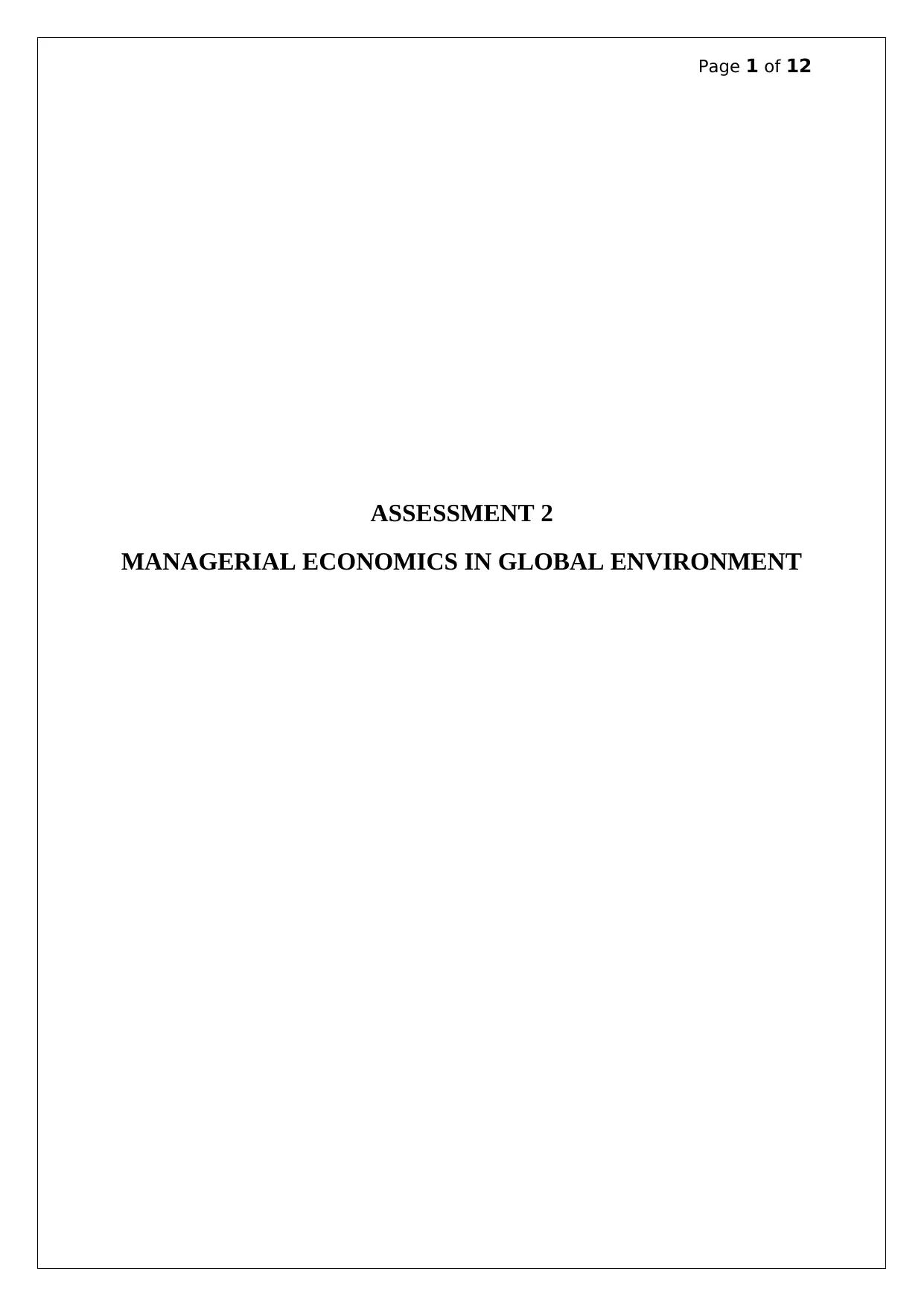
Page 1 of 12
ASSESSMENT 2
MANAGERIAL ECONOMICS IN GLOBAL ENVIRONMENT
ASSESSMENT 2
MANAGERIAL ECONOMICS IN GLOBAL ENVIRONMENT
Paraphrase This Document
Need a fresh take? Get an instant paraphrase of this document with our AI Paraphraser
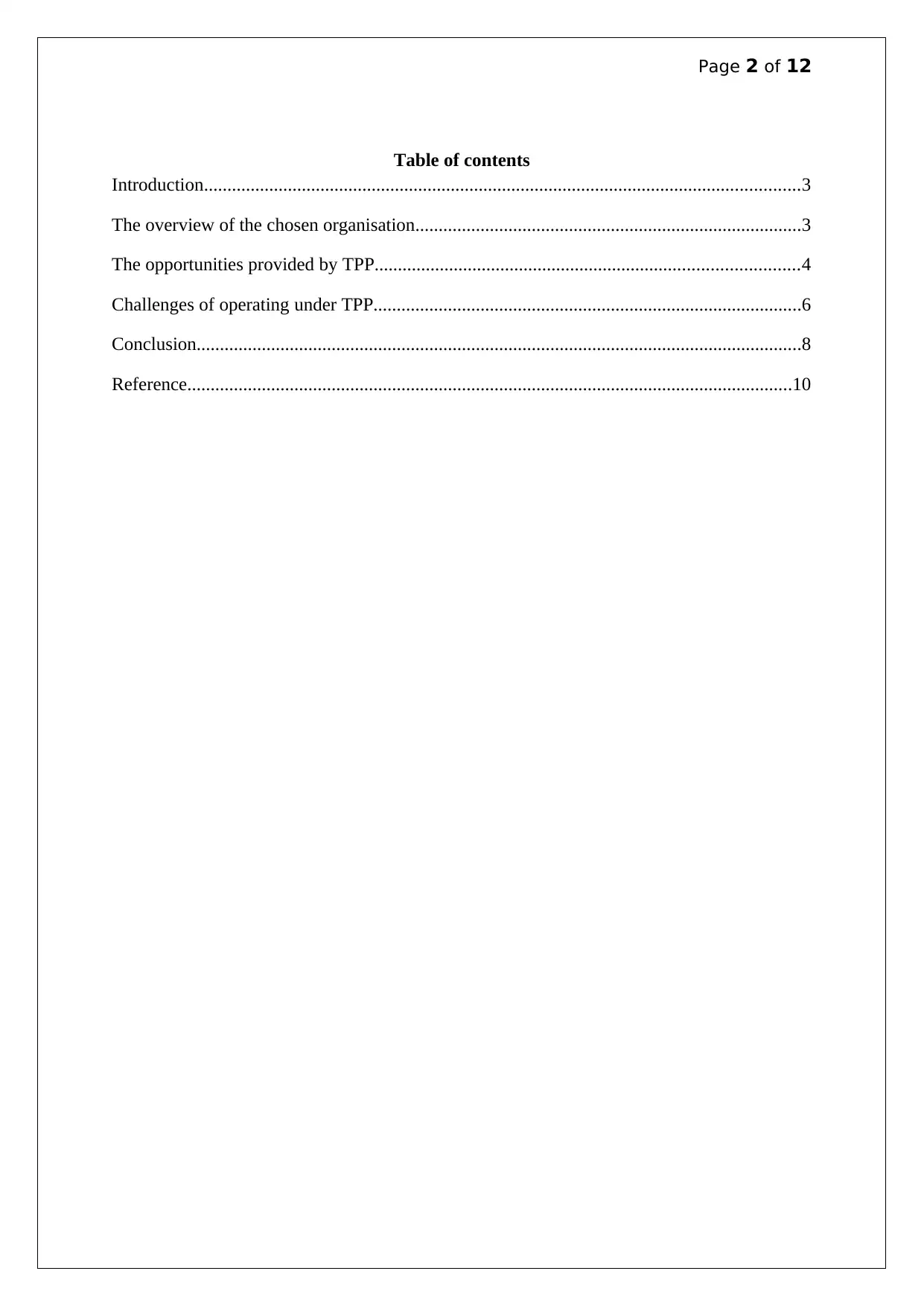
Page 2 of 12
Table of contents
Introduction................................................................................................................................3
The overview of the chosen organisation...................................................................................3
The opportunities provided by TPP...........................................................................................4
Challenges of operating under TPP............................................................................................6
Conclusion..................................................................................................................................8
Reference..................................................................................................................................10
Table of contents
Introduction................................................................................................................................3
The overview of the chosen organisation...................................................................................3
The opportunities provided by TPP...........................................................................................4
Challenges of operating under TPP............................................................................................6
Conclusion..................................................................................................................................8
Reference..................................................................................................................................10
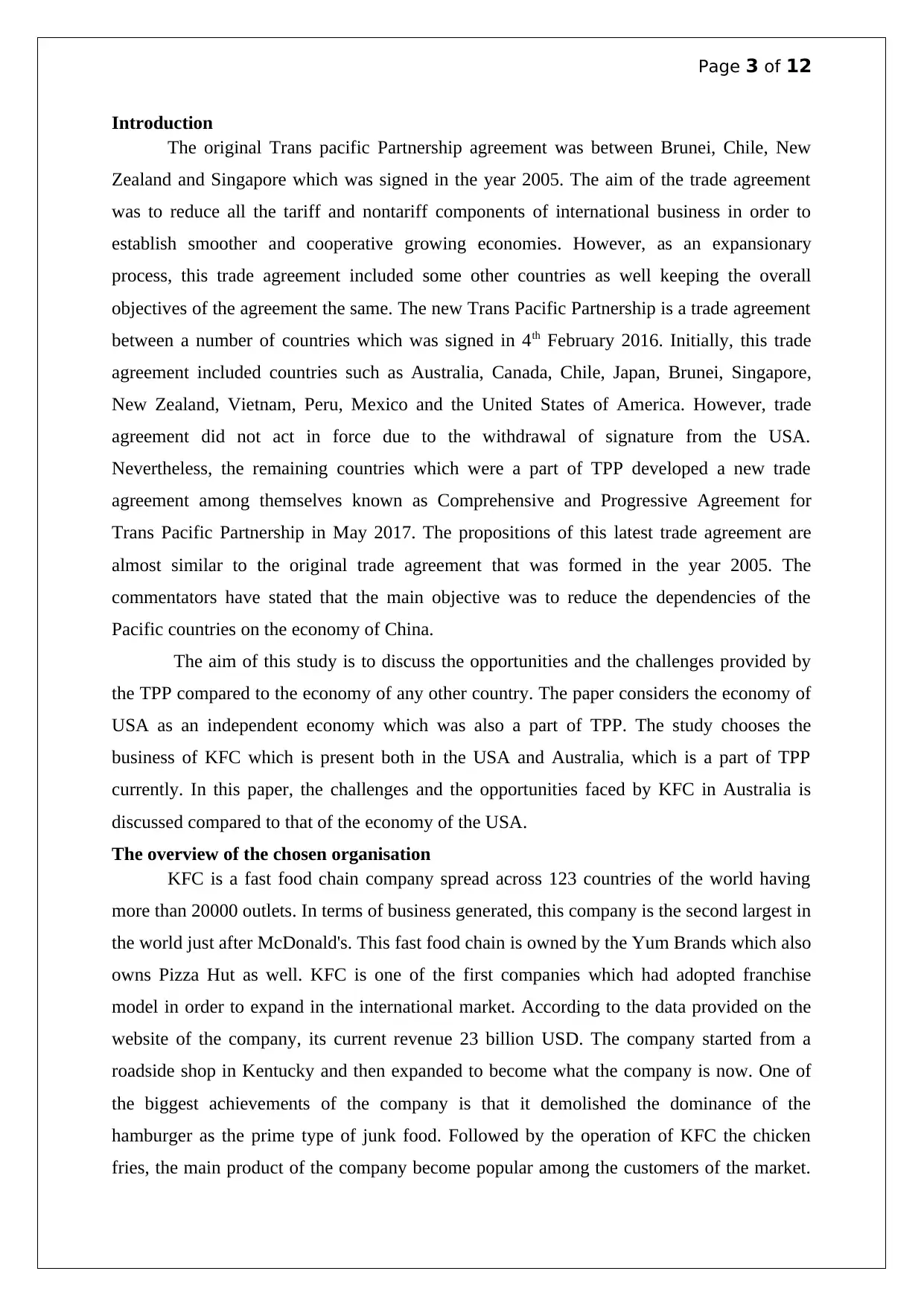
Page 3 of 12
Introduction
The original Trans pacific Partnership agreement was between Brunei, Chile, New
Zealand and Singapore which was signed in the year 2005. The aim of the trade agreement
was to reduce all the tariff and nontariff components of international business in order to
establish smoother and cooperative growing economies. However, as an expansionary
process, this trade agreement included some other countries as well keeping the overall
objectives of the agreement the same. The new Trans Pacific Partnership is a trade agreement
between a number of countries which was signed in 4th February 2016. Initially, this trade
agreement included countries such as Australia, Canada, Chile, Japan, Brunei, Singapore,
New Zealand, Vietnam, Peru, Mexico and the United States of America. However, trade
agreement did not act in force due to the withdrawal of signature from the USA.
Nevertheless, the remaining countries which were a part of TPP developed a new trade
agreement among themselves known as Comprehensive and Progressive Agreement for
Trans Pacific Partnership in May 2017. The propositions of this latest trade agreement are
almost similar to the original trade agreement that was formed in the year 2005. The
commentators have stated that the main objective was to reduce the dependencies of the
Pacific countries on the economy of China.
The aim of this study is to discuss the opportunities and the challenges provided by
the TPP compared to the economy of any other country. The paper considers the economy of
USA as an independent economy which was also a part of TPP. The study chooses the
business of KFC which is present both in the USA and Australia, which is a part of TPP
currently. In this paper, the challenges and the opportunities faced by KFC in Australia is
discussed compared to that of the economy of the USA.
The overview of the chosen organisation
KFC is a fast food chain company spread across 123 countries of the world having
more than 20000 outlets. In terms of business generated, this company is the second largest in
the world just after McDonald's. This fast food chain is owned by the Yum Brands which also
owns Pizza Hut as well. KFC is one of the first companies which had adopted franchise
model in order to expand in the international market. According to the data provided on the
website of the company, its current revenue 23 billion USD. The company started from a
roadside shop in Kentucky and then expanded to become what the company is now. One of
the biggest achievements of the company is that it demolished the dominance of the
hamburger as the prime type of junk food. Followed by the operation of KFC the chicken
fries, the main product of the company become popular among the customers of the market.
Introduction
The original Trans pacific Partnership agreement was between Brunei, Chile, New
Zealand and Singapore which was signed in the year 2005. The aim of the trade agreement
was to reduce all the tariff and nontariff components of international business in order to
establish smoother and cooperative growing economies. However, as an expansionary
process, this trade agreement included some other countries as well keeping the overall
objectives of the agreement the same. The new Trans Pacific Partnership is a trade agreement
between a number of countries which was signed in 4th February 2016. Initially, this trade
agreement included countries such as Australia, Canada, Chile, Japan, Brunei, Singapore,
New Zealand, Vietnam, Peru, Mexico and the United States of America. However, trade
agreement did not act in force due to the withdrawal of signature from the USA.
Nevertheless, the remaining countries which were a part of TPP developed a new trade
agreement among themselves known as Comprehensive and Progressive Agreement for
Trans Pacific Partnership in May 2017. The propositions of this latest trade agreement are
almost similar to the original trade agreement that was formed in the year 2005. The
commentators have stated that the main objective was to reduce the dependencies of the
Pacific countries on the economy of China.
The aim of this study is to discuss the opportunities and the challenges provided by
the TPP compared to the economy of any other country. The paper considers the economy of
USA as an independent economy which was also a part of TPP. The study chooses the
business of KFC which is present both in the USA and Australia, which is a part of TPP
currently. In this paper, the challenges and the opportunities faced by KFC in Australia is
discussed compared to that of the economy of the USA.
The overview of the chosen organisation
KFC is a fast food chain company spread across 123 countries of the world having
more than 20000 outlets. In terms of business generated, this company is the second largest in
the world just after McDonald's. This fast food chain is owned by the Yum Brands which also
owns Pizza Hut as well. KFC is one of the first companies which had adopted franchise
model in order to expand in the international market. According to the data provided on the
website of the company, its current revenue 23 billion USD. The company started from a
roadside shop in Kentucky and then expanded to become what the company is now. One of
the biggest achievements of the company is that it demolished the dominance of the
hamburger as the prime type of junk food. Followed by the operation of KFC the chicken
fries, the main product of the company become popular among the customers of the market.
⊘ This is a preview!⊘
Do you want full access?
Subscribe today to unlock all pages.

Trusted by 1+ million students worldwide
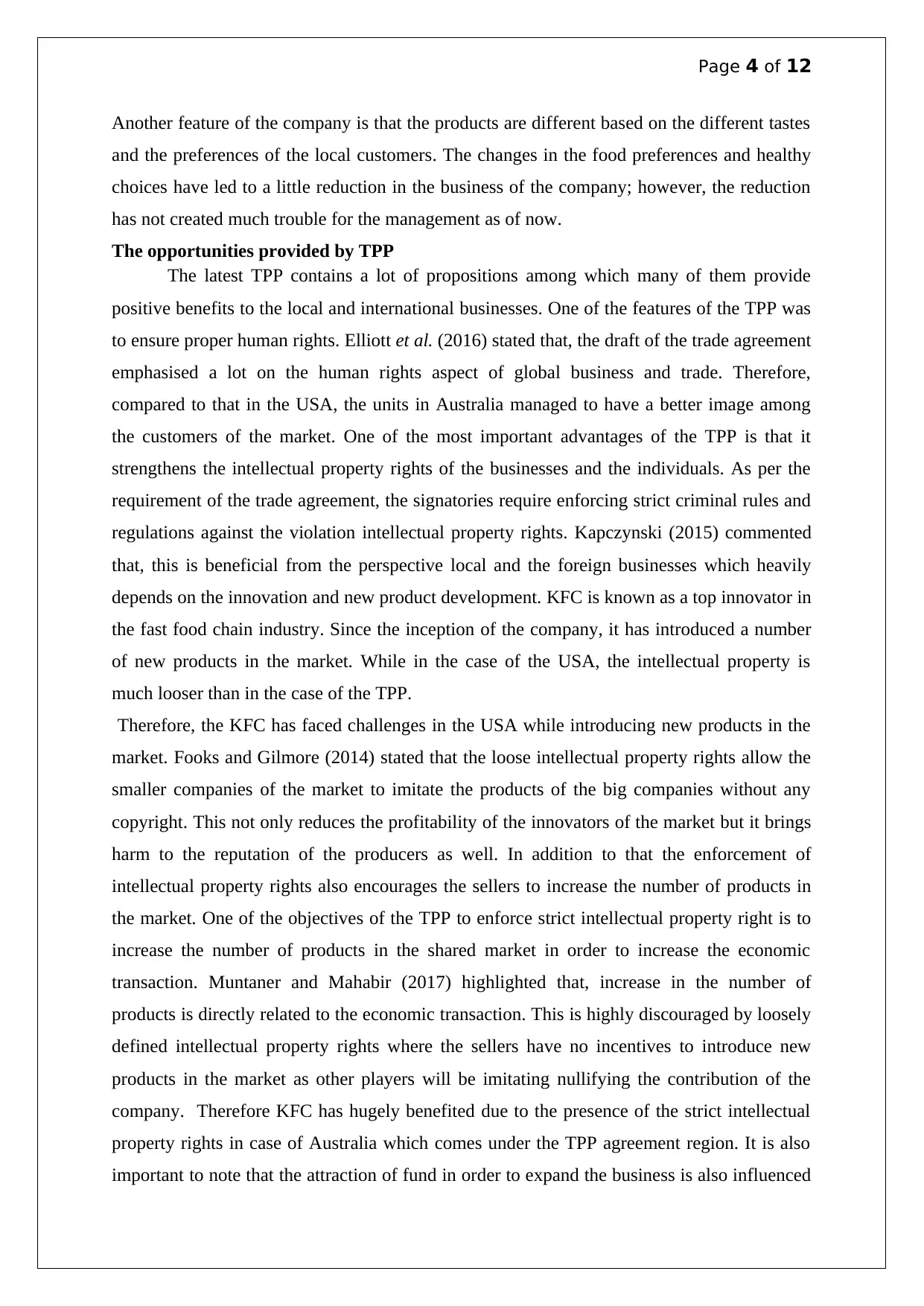
Page 4 of 12
Another feature of the company is that the products are different based on the different tastes
and the preferences of the local customers. The changes in the food preferences and healthy
choices have led to a little reduction in the business of the company; however, the reduction
has not created much trouble for the management as of now.
The opportunities provided by TPP
The latest TPP contains a lot of propositions among which many of them provide
positive benefits to the local and international businesses. One of the features of the TPP was
to ensure proper human rights. Elliott et al. (2016) stated that, the draft of the trade agreement
emphasised a lot on the human rights aspect of global business and trade. Therefore,
compared to that in the USA, the units in Australia managed to have a better image among
the customers of the market. One of the most important advantages of the TPP is that it
strengthens the intellectual property rights of the businesses and the individuals. As per the
requirement of the trade agreement, the signatories require enforcing strict criminal rules and
regulations against the violation intellectual property rights. Kapczynski (2015) commented
that, this is beneficial from the perspective local and the foreign businesses which heavily
depends on the innovation and new product development. KFC is known as a top innovator in
the fast food chain industry. Since the inception of the company, it has introduced a number
of new products in the market. While in the case of the USA, the intellectual property is
much looser than in the case of the TPP.
Therefore, the KFC has faced challenges in the USA while introducing new products in the
market. Fooks and Gilmore (2014) stated that the loose intellectual property rights allow the
smaller companies of the market to imitate the products of the big companies without any
copyright. This not only reduces the profitability of the innovators of the market but it brings
harm to the reputation of the producers as well. In addition to that the enforcement of
intellectual property rights also encourages the sellers to increase the number of products in
the market. One of the objectives of the TPP to enforce strict intellectual property right is to
increase the number of products in the shared market in order to increase the economic
transaction. Muntaner and Mahabir (2017) highlighted that, increase in the number of
products is directly related to the economic transaction. This is highly discouraged by loosely
defined intellectual property rights where the sellers have no incentives to introduce new
products in the market as other players will be imitating nullifying the contribution of the
company. Therefore KFC has hugely benefited due to the presence of the strict intellectual
property rights in case of Australia which comes under the TPP agreement region. It is also
important to note that the attraction of fund in order to expand the business is also influenced
Another feature of the company is that the products are different based on the different tastes
and the preferences of the local customers. The changes in the food preferences and healthy
choices have led to a little reduction in the business of the company; however, the reduction
has not created much trouble for the management as of now.
The opportunities provided by TPP
The latest TPP contains a lot of propositions among which many of them provide
positive benefits to the local and international businesses. One of the features of the TPP was
to ensure proper human rights. Elliott et al. (2016) stated that, the draft of the trade agreement
emphasised a lot on the human rights aspect of global business and trade. Therefore,
compared to that in the USA, the units in Australia managed to have a better image among
the customers of the market. One of the most important advantages of the TPP is that it
strengthens the intellectual property rights of the businesses and the individuals. As per the
requirement of the trade agreement, the signatories require enforcing strict criminal rules and
regulations against the violation intellectual property rights. Kapczynski (2015) commented
that, this is beneficial from the perspective local and the foreign businesses which heavily
depends on the innovation and new product development. KFC is known as a top innovator in
the fast food chain industry. Since the inception of the company, it has introduced a number
of new products in the market. While in the case of the USA, the intellectual property is
much looser than in the case of the TPP.
Therefore, the KFC has faced challenges in the USA while introducing new products in the
market. Fooks and Gilmore (2014) stated that the loose intellectual property rights allow the
smaller companies of the market to imitate the products of the big companies without any
copyright. This not only reduces the profitability of the innovators of the market but it brings
harm to the reputation of the producers as well. In addition to that the enforcement of
intellectual property rights also encourages the sellers to increase the number of products in
the market. One of the objectives of the TPP to enforce strict intellectual property right is to
increase the number of products in the shared market in order to increase the economic
transaction. Muntaner and Mahabir (2017) highlighted that, increase in the number of
products is directly related to the economic transaction. This is highly discouraged by loosely
defined intellectual property rights where the sellers have no incentives to introduce new
products in the market as other players will be imitating nullifying the contribution of the
company. Therefore KFC has hugely benefited due to the presence of the strict intellectual
property rights in case of Australia which comes under the TPP agreement region. It is also
important to note that the attraction of fund in order to expand the business is also influenced
Paraphrase This Document
Need a fresh take? Get an instant paraphrase of this document with our AI Paraphraser
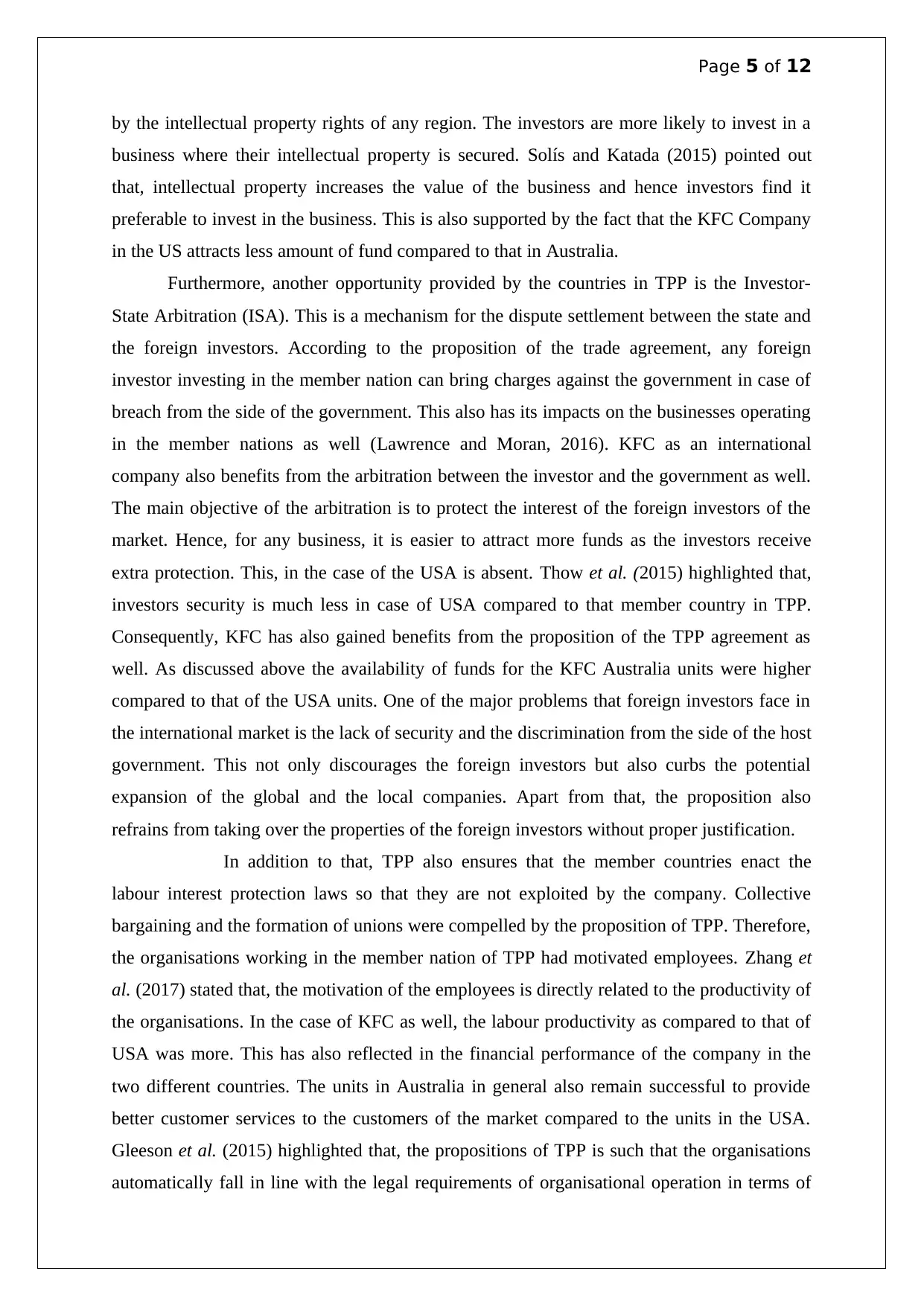
Page 5 of 12
by the intellectual property rights of any region. The investors are more likely to invest in a
business where their intellectual property is secured. Solís and Katada (2015) pointed out
that, intellectual property increases the value of the business and hence investors find it
preferable to invest in the business. This is also supported by the fact that the KFC Company
in the US attracts less amount of fund compared to that in Australia.
Furthermore, another opportunity provided by the countries in TPP is the Investor-
State Arbitration (ISA). This is a mechanism for the dispute settlement between the state and
the foreign investors. According to the proposition of the trade agreement, any foreign
investor investing in the member nation can bring charges against the government in case of
breach from the side of the government. This also has its impacts on the businesses operating
in the member nations as well (Lawrence and Moran, 2016). KFC as an international
company also benefits from the arbitration between the investor and the government as well.
The main objective of the arbitration is to protect the interest of the foreign investors of the
market. Hence, for any business, it is easier to attract more funds as the investors receive
extra protection. This, in the case of the USA is absent. Thow et al. (2015) highlighted that,
investors security is much less in case of USA compared to that member country in TPP.
Consequently, KFC has also gained benefits from the proposition of the TPP agreement as
well. As discussed above the availability of funds for the KFC Australia units were higher
compared to that of the USA units. One of the major problems that foreign investors face in
the international market is the lack of security and the discrimination from the side of the host
government. This not only discourages the foreign investors but also curbs the potential
expansion of the global and the local companies. Apart from that, the proposition also
refrains from taking over the properties of the foreign investors without proper justification.
In addition to that, TPP also ensures that the member countries enact the
labour interest protection laws so that they are not exploited by the company. Collective
bargaining and the formation of unions were compelled by the proposition of TPP. Therefore,
the organisations working in the member nation of TPP had motivated employees. Zhang et
al. (2017) stated that, the motivation of the employees is directly related to the productivity of
the organisations. In the case of KFC as well, the labour productivity as compared to that of
USA was more. This has also reflected in the financial performance of the company in the
two different countries. The units in Australia in general also remain successful to provide
better customer services to the customers of the market compared to the units in the USA.
Gleeson et al. (2015) highlighted that, the propositions of TPP is such that the organisations
automatically fall in line with the legal requirements of organisational operation in terms of
by the intellectual property rights of any region. The investors are more likely to invest in a
business where their intellectual property is secured. Solís and Katada (2015) pointed out
that, intellectual property increases the value of the business and hence investors find it
preferable to invest in the business. This is also supported by the fact that the KFC Company
in the US attracts less amount of fund compared to that in Australia.
Furthermore, another opportunity provided by the countries in TPP is the Investor-
State Arbitration (ISA). This is a mechanism for the dispute settlement between the state and
the foreign investors. According to the proposition of the trade agreement, any foreign
investor investing in the member nation can bring charges against the government in case of
breach from the side of the government. This also has its impacts on the businesses operating
in the member nations as well (Lawrence and Moran, 2016). KFC as an international
company also benefits from the arbitration between the investor and the government as well.
The main objective of the arbitration is to protect the interest of the foreign investors of the
market. Hence, for any business, it is easier to attract more funds as the investors receive
extra protection. This, in the case of the USA is absent. Thow et al. (2015) highlighted that,
investors security is much less in case of USA compared to that member country in TPP.
Consequently, KFC has also gained benefits from the proposition of the TPP agreement as
well. As discussed above the availability of funds for the KFC Australia units were higher
compared to that of the USA units. One of the major problems that foreign investors face in
the international market is the lack of security and the discrimination from the side of the host
government. This not only discourages the foreign investors but also curbs the potential
expansion of the global and the local companies. Apart from that, the proposition also
refrains from taking over the properties of the foreign investors without proper justification.
In addition to that, TPP also ensures that the member countries enact the
labour interest protection laws so that they are not exploited by the company. Collective
bargaining and the formation of unions were compelled by the proposition of TPP. Therefore,
the organisations working in the member nation of TPP had motivated employees. Zhang et
al. (2017) stated that, the motivation of the employees is directly related to the productivity of
the organisations. In the case of KFC as well, the labour productivity as compared to that of
USA was more. This has also reflected in the financial performance of the company in the
two different countries. The units in Australia in general also remain successful to provide
better customer services to the customers of the market compared to the units in the USA.
Gleeson et al. (2015) highlighted that, the propositions of TPP is such that the organisations
automatically fall in line with the legal requirements of organisational operation in terms of
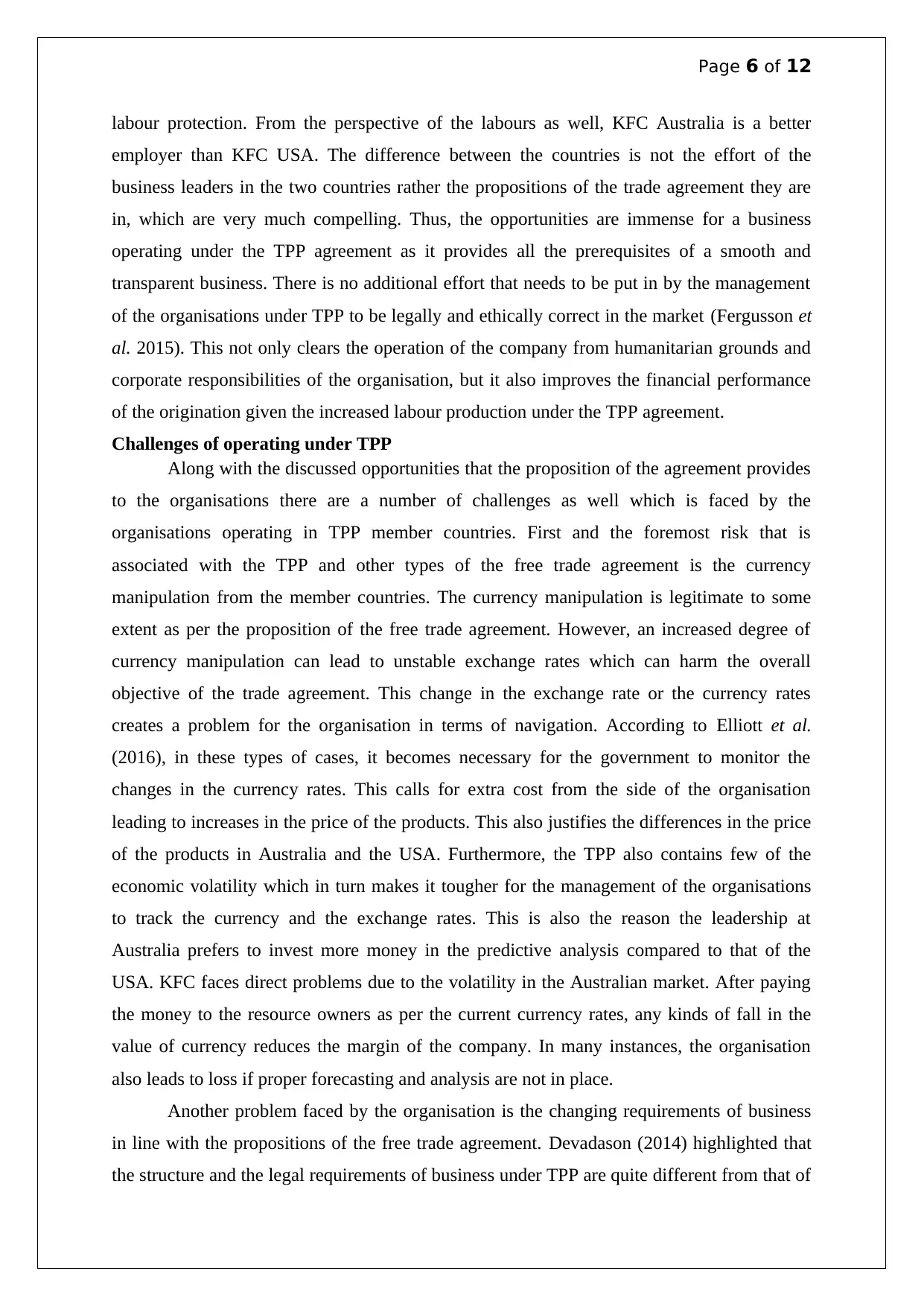
Page 6 of 12
labour protection. From the perspective of the labours as well, KFC Australia is a better
employer than KFC USA. The difference between the countries is not the effort of the
business leaders in the two countries rather the propositions of the trade agreement they are
in, which are very much compelling. Thus, the opportunities are immense for a business
operating under the TPP agreement as it provides all the prerequisites of a smooth and
transparent business. There is no additional effort that needs to be put in by the management
of the organisations under TPP to be legally and ethically correct in the market (Fergusson et
al. 2015). This not only clears the operation of the company from humanitarian grounds and
corporate responsibilities of the organisation, but it also improves the financial performance
of the origination given the increased labour production under the TPP agreement.
Challenges of operating under TPP
Along with the discussed opportunities that the proposition of the agreement provides
to the organisations there are a number of challenges as well which is faced by the
organisations operating in TPP member countries. First and the foremost risk that is
associated with the TPP and other types of the free trade agreement is the currency
manipulation from the member countries. The currency manipulation is legitimate to some
extent as per the proposition of the free trade agreement. However, an increased degree of
currency manipulation can lead to unstable exchange rates which can harm the overall
objective of the trade agreement. This change in the exchange rate or the currency rates
creates a problem for the organisation in terms of navigation. According to Elliott et al.
(2016), in these types of cases, it becomes necessary for the government to monitor the
changes in the currency rates. This calls for extra cost from the side of the organisation
leading to increases in the price of the products. This also justifies the differences in the price
of the products in Australia and the USA. Furthermore, the TPP also contains few of the
economic volatility which in turn makes it tougher for the management of the organisations
to track the currency and the exchange rates. This is also the reason the leadership at
Australia prefers to invest more money in the predictive analysis compared to that of the
USA. KFC faces direct problems due to the volatility in the Australian market. After paying
the money to the resource owners as per the current currency rates, any kinds of fall in the
value of currency reduces the margin of the company. In many instances, the organisation
also leads to loss if proper forecasting and analysis are not in place.
Another problem faced by the organisation is the changing requirements of business
in line with the propositions of the free trade agreement. Devadason (2014) highlighted that
the structure and the legal requirements of business under TPP are quite different from that of
labour protection. From the perspective of the labours as well, KFC Australia is a better
employer than KFC USA. The difference between the countries is not the effort of the
business leaders in the two countries rather the propositions of the trade agreement they are
in, which are very much compelling. Thus, the opportunities are immense for a business
operating under the TPP agreement as it provides all the prerequisites of a smooth and
transparent business. There is no additional effort that needs to be put in by the management
of the organisations under TPP to be legally and ethically correct in the market (Fergusson et
al. 2015). This not only clears the operation of the company from humanitarian grounds and
corporate responsibilities of the organisation, but it also improves the financial performance
of the origination given the increased labour production under the TPP agreement.
Challenges of operating under TPP
Along with the discussed opportunities that the proposition of the agreement provides
to the organisations there are a number of challenges as well which is faced by the
organisations operating in TPP member countries. First and the foremost risk that is
associated with the TPP and other types of the free trade agreement is the currency
manipulation from the member countries. The currency manipulation is legitimate to some
extent as per the proposition of the free trade agreement. However, an increased degree of
currency manipulation can lead to unstable exchange rates which can harm the overall
objective of the trade agreement. This change in the exchange rate or the currency rates
creates a problem for the organisation in terms of navigation. According to Elliott et al.
(2016), in these types of cases, it becomes necessary for the government to monitor the
changes in the currency rates. This calls for extra cost from the side of the organisation
leading to increases in the price of the products. This also justifies the differences in the price
of the products in Australia and the USA. Furthermore, the TPP also contains few of the
economic volatility which in turn makes it tougher for the management of the organisations
to track the currency and the exchange rates. This is also the reason the leadership at
Australia prefers to invest more money in the predictive analysis compared to that of the
USA. KFC faces direct problems due to the volatility in the Australian market. After paying
the money to the resource owners as per the current currency rates, any kinds of fall in the
value of currency reduces the margin of the company. In many instances, the organisation
also leads to loss if proper forecasting and analysis are not in place.
Another problem faced by the organisation is the changing requirements of business
in line with the propositions of the free trade agreement. Devadason (2014) highlighted that
the structure and the legal requirements of business under TPP are quite different from that of
⊘ This is a preview!⊘
Do you want full access?
Subscribe today to unlock all pages.

Trusted by 1+ million students worldwide
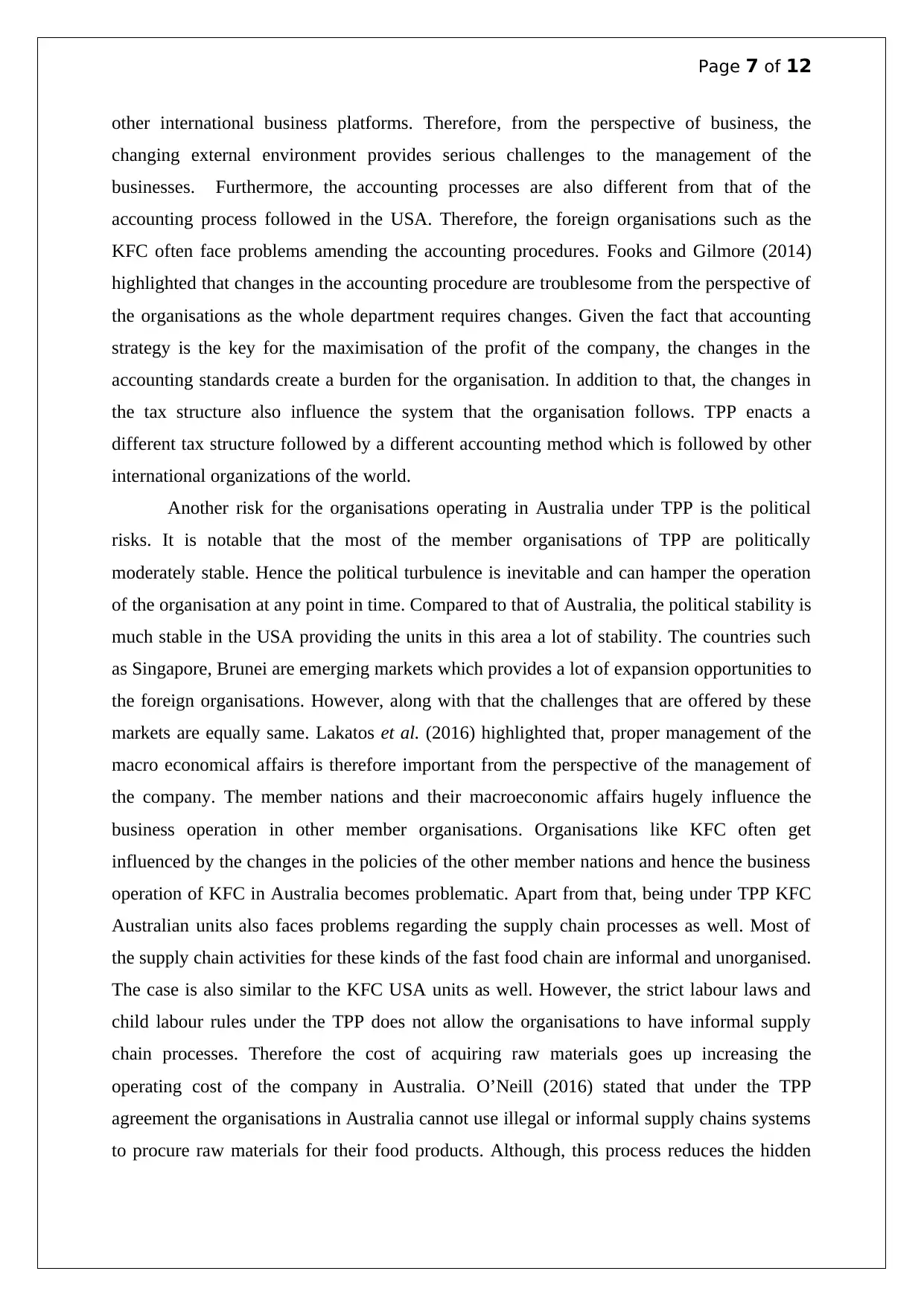
Page 7 of 12
other international business platforms. Therefore, from the perspective of business, the
changing external environment provides serious challenges to the management of the
businesses. Furthermore, the accounting processes are also different from that of the
accounting process followed in the USA. Therefore, the foreign organisations such as the
KFC often face problems amending the accounting procedures. Fooks and Gilmore (2014)
highlighted that changes in the accounting procedure are troublesome from the perspective of
the organisations as the whole department requires changes. Given the fact that accounting
strategy is the key for the maximisation of the profit of the company, the changes in the
accounting standards create a burden for the organisation. In addition to that, the changes in
the tax structure also influence the system that the organisation follows. TPP enacts a
different tax structure followed by a different accounting method which is followed by other
international organizations of the world.
Another risk for the organisations operating in Australia under TPP is the political
risks. It is notable that the most of the member organisations of TPP are politically
moderately stable. Hence the political turbulence is inevitable and can hamper the operation
of the organisation at any point in time. Compared to that of Australia, the political stability is
much stable in the USA providing the units in this area a lot of stability. The countries such
as Singapore, Brunei are emerging markets which provides a lot of expansion opportunities to
the foreign organisations. However, along with that the challenges that are offered by these
markets are equally same. Lakatos et al. (2016) highlighted that, proper management of the
macro economical affairs is therefore important from the perspective of the management of
the company. The member nations and their macroeconomic affairs hugely influence the
business operation in other member organisations. Organisations like KFC often get
influenced by the changes in the policies of the other member nations and hence the business
operation of KFC in Australia becomes problematic. Apart from that, being under TPP KFC
Australian units also faces problems regarding the supply chain processes as well. Most of
the supply chain activities for these kinds of the fast food chain are informal and unorganised.
The case is also similar to the KFC USA units as well. However, the strict labour laws and
child labour rules under the TPP does not allow the organisations to have informal supply
chain processes. Therefore the cost of acquiring raw materials goes up increasing the
operating cost of the company in Australia. O’Neill (2016) stated that under the TPP
agreement the organisations in Australia cannot use illegal or informal supply chains systems
to procure raw materials for their food products. Although, this process reduces the hidden
other international business platforms. Therefore, from the perspective of business, the
changing external environment provides serious challenges to the management of the
businesses. Furthermore, the accounting processes are also different from that of the
accounting process followed in the USA. Therefore, the foreign organisations such as the
KFC often face problems amending the accounting procedures. Fooks and Gilmore (2014)
highlighted that changes in the accounting procedure are troublesome from the perspective of
the organisations as the whole department requires changes. Given the fact that accounting
strategy is the key for the maximisation of the profit of the company, the changes in the
accounting standards create a burden for the organisation. In addition to that, the changes in
the tax structure also influence the system that the organisation follows. TPP enacts a
different tax structure followed by a different accounting method which is followed by other
international organizations of the world.
Another risk for the organisations operating in Australia under TPP is the political
risks. It is notable that the most of the member organisations of TPP are politically
moderately stable. Hence the political turbulence is inevitable and can hamper the operation
of the organisation at any point in time. Compared to that of Australia, the political stability is
much stable in the USA providing the units in this area a lot of stability. The countries such
as Singapore, Brunei are emerging markets which provides a lot of expansion opportunities to
the foreign organisations. However, along with that the challenges that are offered by these
markets are equally same. Lakatos et al. (2016) highlighted that, proper management of the
macro economical affairs is therefore important from the perspective of the management of
the company. The member nations and their macroeconomic affairs hugely influence the
business operation in other member organisations. Organisations like KFC often get
influenced by the changes in the policies of the other member nations and hence the business
operation of KFC in Australia becomes problematic. Apart from that, being under TPP KFC
Australian units also faces problems regarding the supply chain processes as well. Most of
the supply chain activities for these kinds of the fast food chain are informal and unorganised.
The case is also similar to the KFC USA units as well. However, the strict labour laws and
child labour rules under the TPP does not allow the organisations to have informal supply
chain processes. Therefore the cost of acquiring raw materials goes up increasing the
operating cost of the company in Australia. O’Neill (2016) stated that under the TPP
agreement the organisations in Australia cannot use illegal or informal supply chains systems
to procure raw materials for their food products. Although, this process reduces the hidden
Paraphrase This Document
Need a fresh take? Get an instant paraphrase of this document with our AI Paraphraser
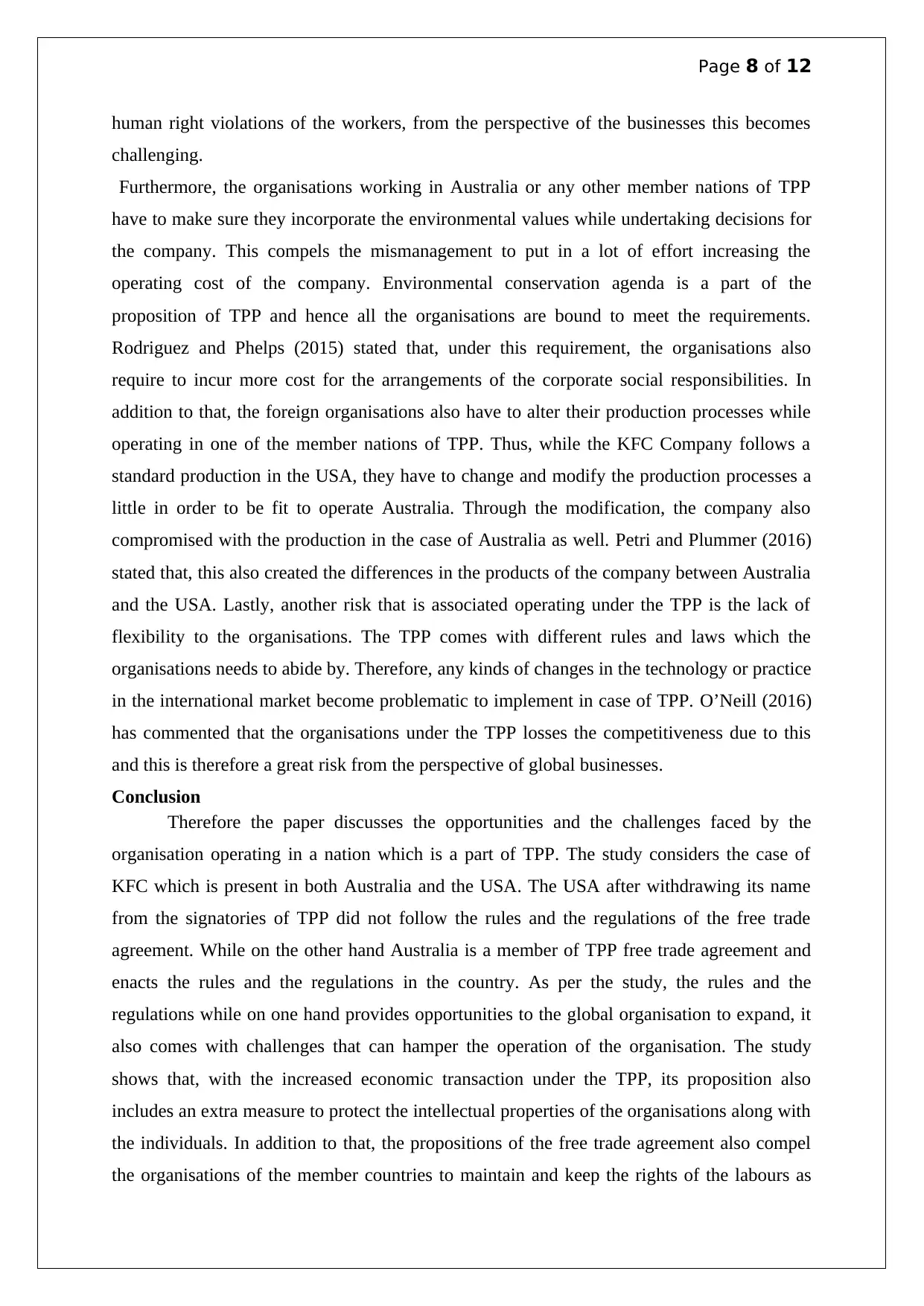
Page 8 of 12
human right violations of the workers, from the perspective of the businesses this becomes
challenging.
Furthermore, the organisations working in Australia or any other member nations of TPP
have to make sure they incorporate the environmental values while undertaking decisions for
the company. This compels the mismanagement to put in a lot of effort increasing the
operating cost of the company. Environmental conservation agenda is a part of the
proposition of TPP and hence all the organisations are bound to meet the requirements.
Rodriguez and Phelps (2015) stated that, under this requirement, the organisations also
require to incur more cost for the arrangements of the corporate social responsibilities. In
addition to that, the foreign organisations also have to alter their production processes while
operating in one of the member nations of TPP. Thus, while the KFC Company follows a
standard production in the USA, they have to change and modify the production processes a
little in order to be fit to operate Australia. Through the modification, the company also
compromised with the production in the case of Australia as well. Petri and Plummer (2016)
stated that, this also created the differences in the products of the company between Australia
and the USA. Lastly, another risk that is associated operating under the TPP is the lack of
flexibility to the organisations. The TPP comes with different rules and laws which the
organisations needs to abide by. Therefore, any kinds of changes in the technology or practice
in the international market become problematic to implement in case of TPP. O’Neill (2016)
has commented that the organisations under the TPP losses the competitiveness due to this
and this is therefore a great risk from the perspective of global businesses.
Conclusion
Therefore the paper discusses the opportunities and the challenges faced by the
organisation operating in a nation which is a part of TPP. The study considers the case of
KFC which is present in both Australia and the USA. The USA after withdrawing its name
from the signatories of TPP did not follow the rules and the regulations of the free trade
agreement. While on the other hand Australia is a member of TPP free trade agreement and
enacts the rules and the regulations in the country. As per the study, the rules and the
regulations while on one hand provides opportunities to the global organisation to expand, it
also comes with challenges that can hamper the operation of the organisation. The study
shows that, with the increased economic transaction under the TPP, its proposition also
includes an extra measure to protect the intellectual properties of the organisations along with
the individuals. In addition to that, the propositions of the free trade agreement also compel
the organisations of the member countries to maintain and keep the rights of the labours as
human right violations of the workers, from the perspective of the businesses this becomes
challenging.
Furthermore, the organisations working in Australia or any other member nations of TPP
have to make sure they incorporate the environmental values while undertaking decisions for
the company. This compels the mismanagement to put in a lot of effort increasing the
operating cost of the company. Environmental conservation agenda is a part of the
proposition of TPP and hence all the organisations are bound to meet the requirements.
Rodriguez and Phelps (2015) stated that, under this requirement, the organisations also
require to incur more cost for the arrangements of the corporate social responsibilities. In
addition to that, the foreign organisations also have to alter their production processes while
operating in one of the member nations of TPP. Thus, while the KFC Company follows a
standard production in the USA, they have to change and modify the production processes a
little in order to be fit to operate Australia. Through the modification, the company also
compromised with the production in the case of Australia as well. Petri and Plummer (2016)
stated that, this also created the differences in the products of the company between Australia
and the USA. Lastly, another risk that is associated operating under the TPP is the lack of
flexibility to the organisations. The TPP comes with different rules and laws which the
organisations needs to abide by. Therefore, any kinds of changes in the technology or practice
in the international market become problematic to implement in case of TPP. O’Neill (2016)
has commented that the organisations under the TPP losses the competitiveness due to this
and this is therefore a great risk from the perspective of global businesses.
Conclusion
Therefore the paper discusses the opportunities and the challenges faced by the
organisation operating in a nation which is a part of TPP. The study considers the case of
KFC which is present in both Australia and the USA. The USA after withdrawing its name
from the signatories of TPP did not follow the rules and the regulations of the free trade
agreement. While on the other hand Australia is a member of TPP free trade agreement and
enacts the rules and the regulations in the country. As per the study, the rules and the
regulations while on one hand provides opportunities to the global organisation to expand, it
also comes with challenges that can hamper the operation of the organisation. The study
shows that, with the increased economic transaction under the TPP, its proposition also
includes an extra measure to protect the intellectual properties of the organisations along with
the individuals. In addition to that, the propositions of the free trade agreement also compel
the organisations of the member countries to maintain and keep the rights of the labours as
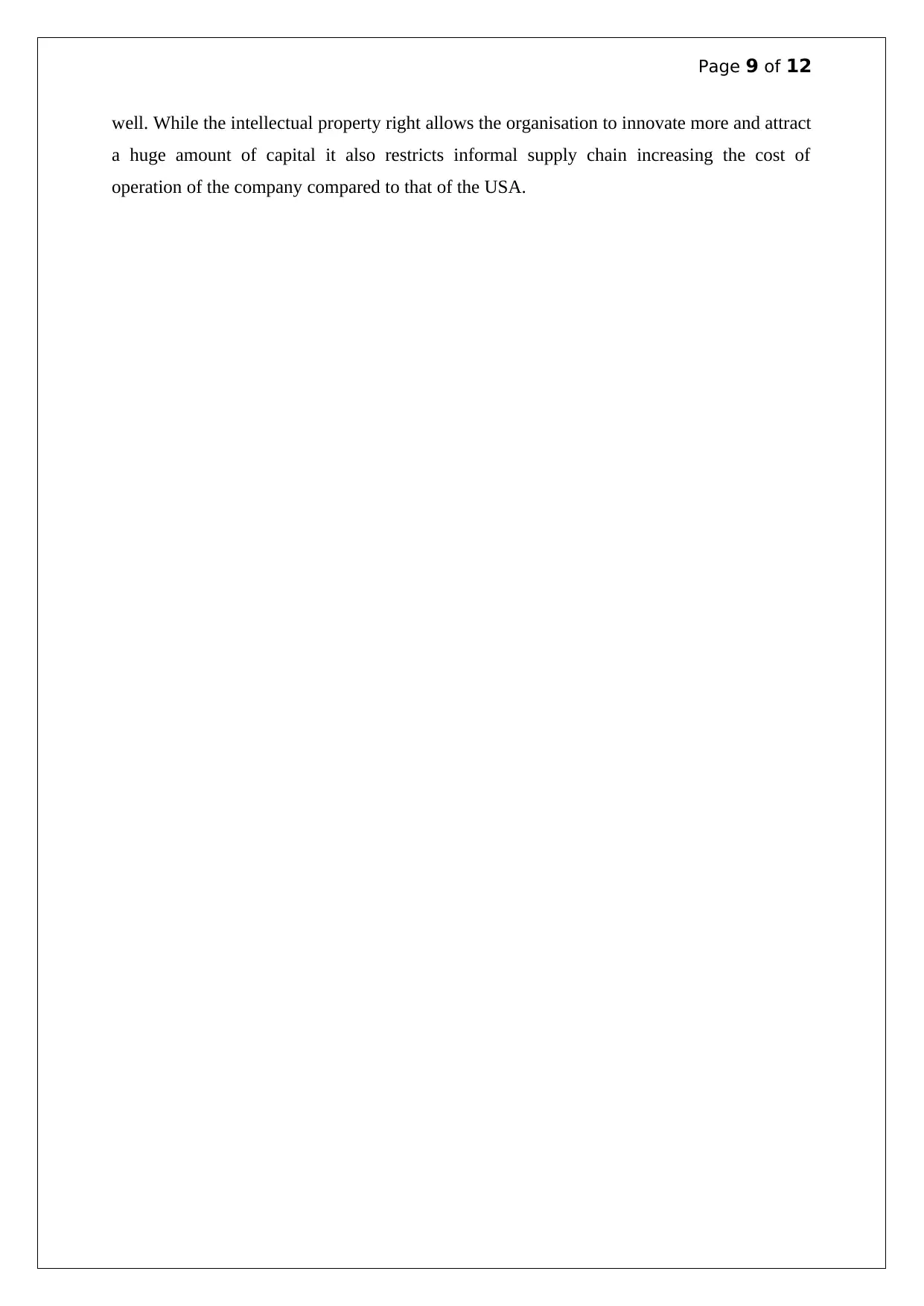
Page 9 of 12
well. While the intellectual property right allows the organisation to innovate more and attract
a huge amount of capital it also restricts informal supply chain increasing the cost of
operation of the company compared to that of the USA.
well. While the intellectual property right allows the organisation to innovate more and attract
a huge amount of capital it also restricts informal supply chain increasing the cost of
operation of the company compared to that of the USA.
⊘ This is a preview!⊘
Do you want full access?
Subscribe today to unlock all pages.

Trusted by 1+ million students worldwide
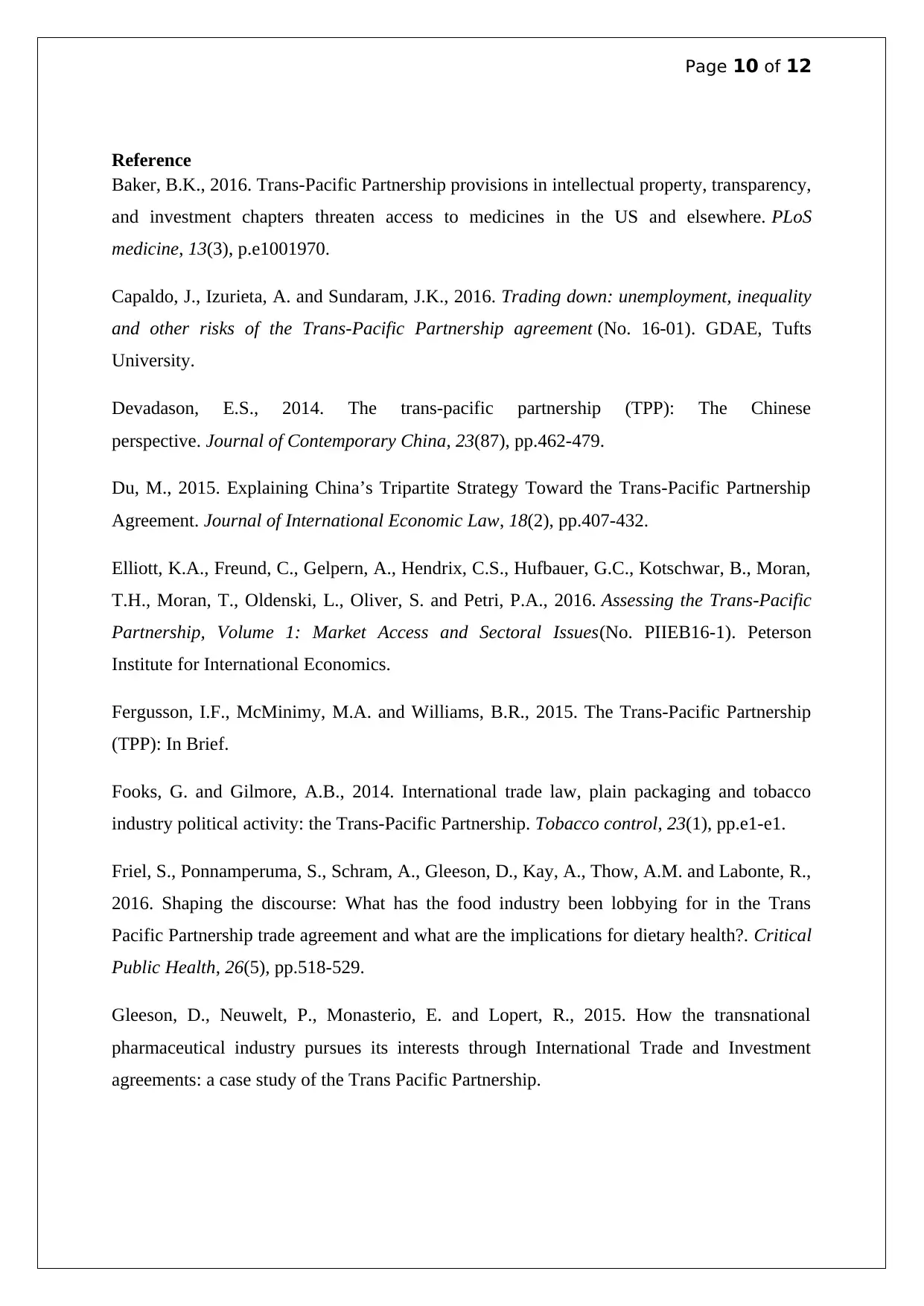
Page 10 of 12
Reference
Baker, B.K., 2016. Trans-Pacific Partnership provisions in intellectual property, transparency,
and investment chapters threaten access to medicines in the US and elsewhere. PLoS
medicine, 13(3), p.e1001970.
Capaldo, J., Izurieta, A. and Sundaram, J.K., 2016. Trading down: unemployment, inequality
and other risks of the Trans-Pacific Partnership agreement (No. 16-01). GDAE, Tufts
University.
Devadason, E.S., 2014. The trans-pacific partnership (TPP): The Chinese
perspective. Journal of Contemporary China, 23(87), pp.462-479.
Du, M., 2015. Explaining China’s Tripartite Strategy Toward the Trans-Pacific Partnership
Agreement. Journal of International Economic Law, 18(2), pp.407-432.
Elliott, K.A., Freund, C., Gelpern, A., Hendrix, C.S., Hufbauer, G.C., Kotschwar, B., Moran,
T.H., Moran, T., Oldenski, L., Oliver, S. and Petri, P.A., 2016. Assessing the Trans-Pacific
Partnership, Volume 1: Market Access and Sectoral Issues(No. PIIEB16-1). Peterson
Institute for International Economics.
Fergusson, I.F., McMinimy, M.A. and Williams, B.R., 2015. The Trans-Pacific Partnership
(TPP): In Brief.
Fooks, G. and Gilmore, A.B., 2014. International trade law, plain packaging and tobacco
industry political activity: the Trans-Pacific Partnership. Tobacco control, 23(1), pp.e1-e1.
Friel, S., Ponnamperuma, S., Schram, A., Gleeson, D., Kay, A., Thow, A.M. and Labonte, R.,
2016. Shaping the discourse: What has the food industry been lobbying for in the Trans
Pacific Partnership trade agreement and what are the implications for dietary health?. Critical
Public Health, 26(5), pp.518-529.
Gleeson, D., Neuwelt, P., Monasterio, E. and Lopert, R., 2015. How the transnational
pharmaceutical industry pursues its interests through International Trade and Investment
agreements: a case study of the Trans Pacific Partnership.
Reference
Baker, B.K., 2016. Trans-Pacific Partnership provisions in intellectual property, transparency,
and investment chapters threaten access to medicines in the US and elsewhere. PLoS
medicine, 13(3), p.e1001970.
Capaldo, J., Izurieta, A. and Sundaram, J.K., 2016. Trading down: unemployment, inequality
and other risks of the Trans-Pacific Partnership agreement (No. 16-01). GDAE, Tufts
University.
Devadason, E.S., 2014. The trans-pacific partnership (TPP): The Chinese
perspective. Journal of Contemporary China, 23(87), pp.462-479.
Du, M., 2015. Explaining China’s Tripartite Strategy Toward the Trans-Pacific Partnership
Agreement. Journal of International Economic Law, 18(2), pp.407-432.
Elliott, K.A., Freund, C., Gelpern, A., Hendrix, C.S., Hufbauer, G.C., Kotschwar, B., Moran,
T.H., Moran, T., Oldenski, L., Oliver, S. and Petri, P.A., 2016. Assessing the Trans-Pacific
Partnership, Volume 1: Market Access and Sectoral Issues(No. PIIEB16-1). Peterson
Institute for International Economics.
Fergusson, I.F., McMinimy, M.A. and Williams, B.R., 2015. The Trans-Pacific Partnership
(TPP): In Brief.
Fooks, G. and Gilmore, A.B., 2014. International trade law, plain packaging and tobacco
industry political activity: the Trans-Pacific Partnership. Tobacco control, 23(1), pp.e1-e1.
Friel, S., Ponnamperuma, S., Schram, A., Gleeson, D., Kay, A., Thow, A.M. and Labonte, R.,
2016. Shaping the discourse: What has the food industry been lobbying for in the Trans
Pacific Partnership trade agreement and what are the implications for dietary health?. Critical
Public Health, 26(5), pp.518-529.
Gleeson, D., Neuwelt, P., Monasterio, E. and Lopert, R., 2015. How the transnational
pharmaceutical industry pursues its interests through International Trade and Investment
agreements: a case study of the Trans Pacific Partnership.
Paraphrase This Document
Need a fresh take? Get an instant paraphrase of this document with our AI Paraphraser
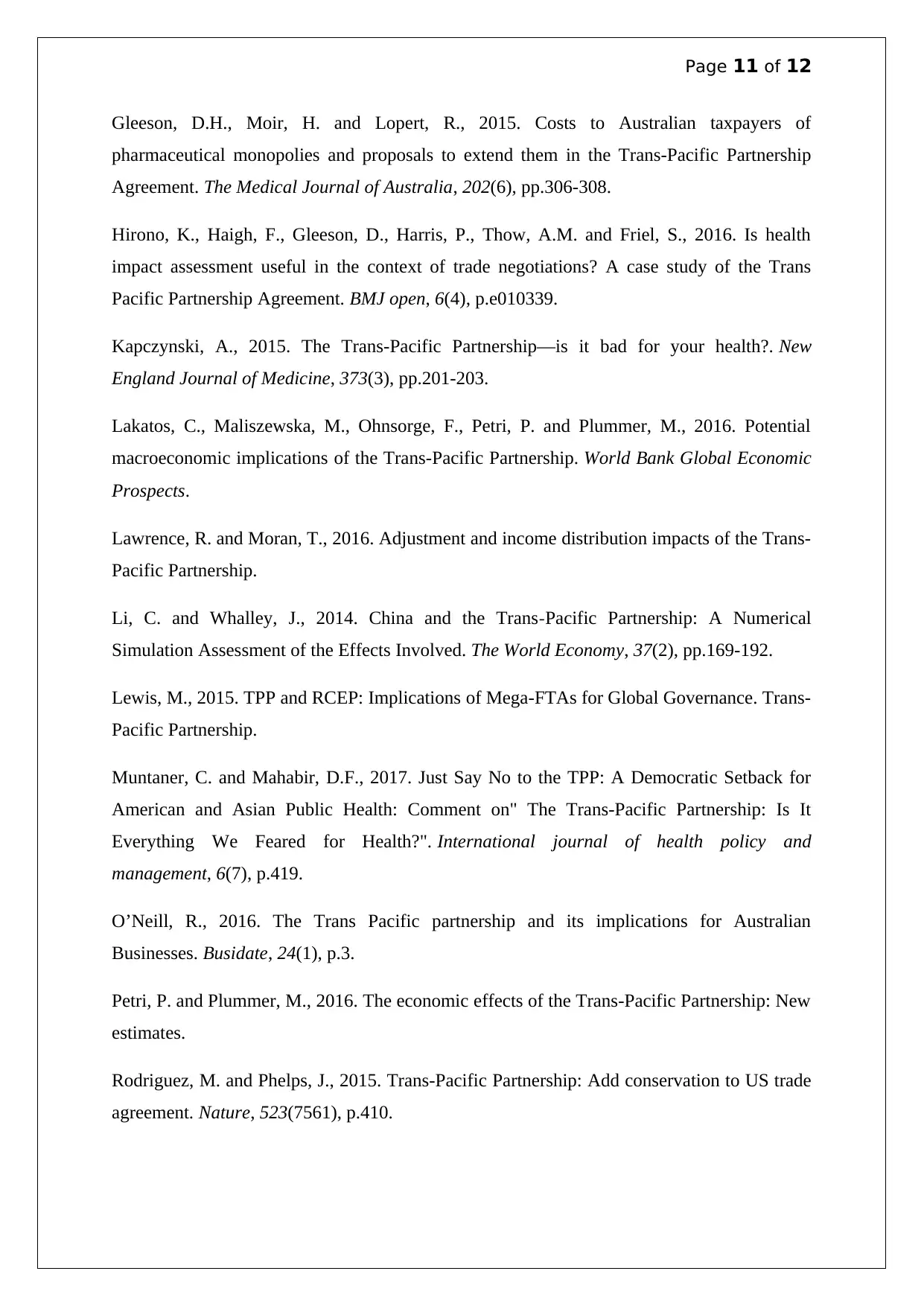
Page 11 of 12
Gleeson, D.H., Moir, H. and Lopert, R., 2015. Costs to Australian taxpayers of
pharmaceutical monopolies and proposals to extend them in the Trans-Pacific Partnership
Agreement. The Medical Journal of Australia, 202(6), pp.306-308.
Hirono, K., Haigh, F., Gleeson, D., Harris, P., Thow, A.M. and Friel, S., 2016. Is health
impact assessment useful in the context of trade negotiations? A case study of the Trans
Pacific Partnership Agreement. BMJ open, 6(4), p.e010339.
Kapczynski, A., 2015. The Trans-Pacific Partnership—is it bad for your health?. New
England Journal of Medicine, 373(3), pp.201-203.
Lakatos, C., Maliszewska, M., Ohnsorge, F., Petri, P. and Plummer, M., 2016. Potential
macroeconomic implications of the Trans-Pacific Partnership. World Bank Global Economic
Prospects.
Lawrence, R. and Moran, T., 2016. Adjustment and income distribution impacts of the Trans-
Pacific Partnership.
Li, C. and Whalley, J., 2014. China and the Trans‐Pacific Partnership: A Numerical
Simulation Assessment of the Effects Involved. The World Economy, 37(2), pp.169-192.
Lewis, M., 2015. TPP and RCEP: Implications of Mega-FTAs for Global Governance. Trans-
Pacific Partnership.
Muntaner, C. and Mahabir, D.F., 2017. Just Say No to the TPP: A Democratic Setback for
American and Asian Public Health: Comment on" The Trans-Pacific Partnership: Is It
Everything We Feared for Health?". International journal of health policy and
management, 6(7), p.419.
O’Neill, R., 2016. The Trans Pacific partnership and its implications for Australian
Businesses. Busidate, 24(1), p.3.
Petri, P. and Plummer, M., 2016. The economic effects of the Trans-Pacific Partnership: New
estimates.
Rodriguez, M. and Phelps, J., 2015. Trans-Pacific Partnership: Add conservation to US trade
agreement. Nature, 523(7561), p.410.
Gleeson, D.H., Moir, H. and Lopert, R., 2015. Costs to Australian taxpayers of
pharmaceutical monopolies and proposals to extend them in the Trans-Pacific Partnership
Agreement. The Medical Journal of Australia, 202(6), pp.306-308.
Hirono, K., Haigh, F., Gleeson, D., Harris, P., Thow, A.M. and Friel, S., 2016. Is health
impact assessment useful in the context of trade negotiations? A case study of the Trans
Pacific Partnership Agreement. BMJ open, 6(4), p.e010339.
Kapczynski, A., 2015. The Trans-Pacific Partnership—is it bad for your health?. New
England Journal of Medicine, 373(3), pp.201-203.
Lakatos, C., Maliszewska, M., Ohnsorge, F., Petri, P. and Plummer, M., 2016. Potential
macroeconomic implications of the Trans-Pacific Partnership. World Bank Global Economic
Prospects.
Lawrence, R. and Moran, T., 2016. Adjustment and income distribution impacts of the Trans-
Pacific Partnership.
Li, C. and Whalley, J., 2014. China and the Trans‐Pacific Partnership: A Numerical
Simulation Assessment of the Effects Involved. The World Economy, 37(2), pp.169-192.
Lewis, M., 2015. TPP and RCEP: Implications of Mega-FTAs for Global Governance. Trans-
Pacific Partnership.
Muntaner, C. and Mahabir, D.F., 2017. Just Say No to the TPP: A Democratic Setback for
American and Asian Public Health: Comment on" The Trans-Pacific Partnership: Is It
Everything We Feared for Health?". International journal of health policy and
management, 6(7), p.419.
O’Neill, R., 2016. The Trans Pacific partnership and its implications for Australian
Businesses. Busidate, 24(1), p.3.
Petri, P. and Plummer, M., 2016. The economic effects of the Trans-Pacific Partnership: New
estimates.
Rodriguez, M. and Phelps, J., 2015. Trans-Pacific Partnership: Add conservation to US trade
agreement. Nature, 523(7561), p.410.
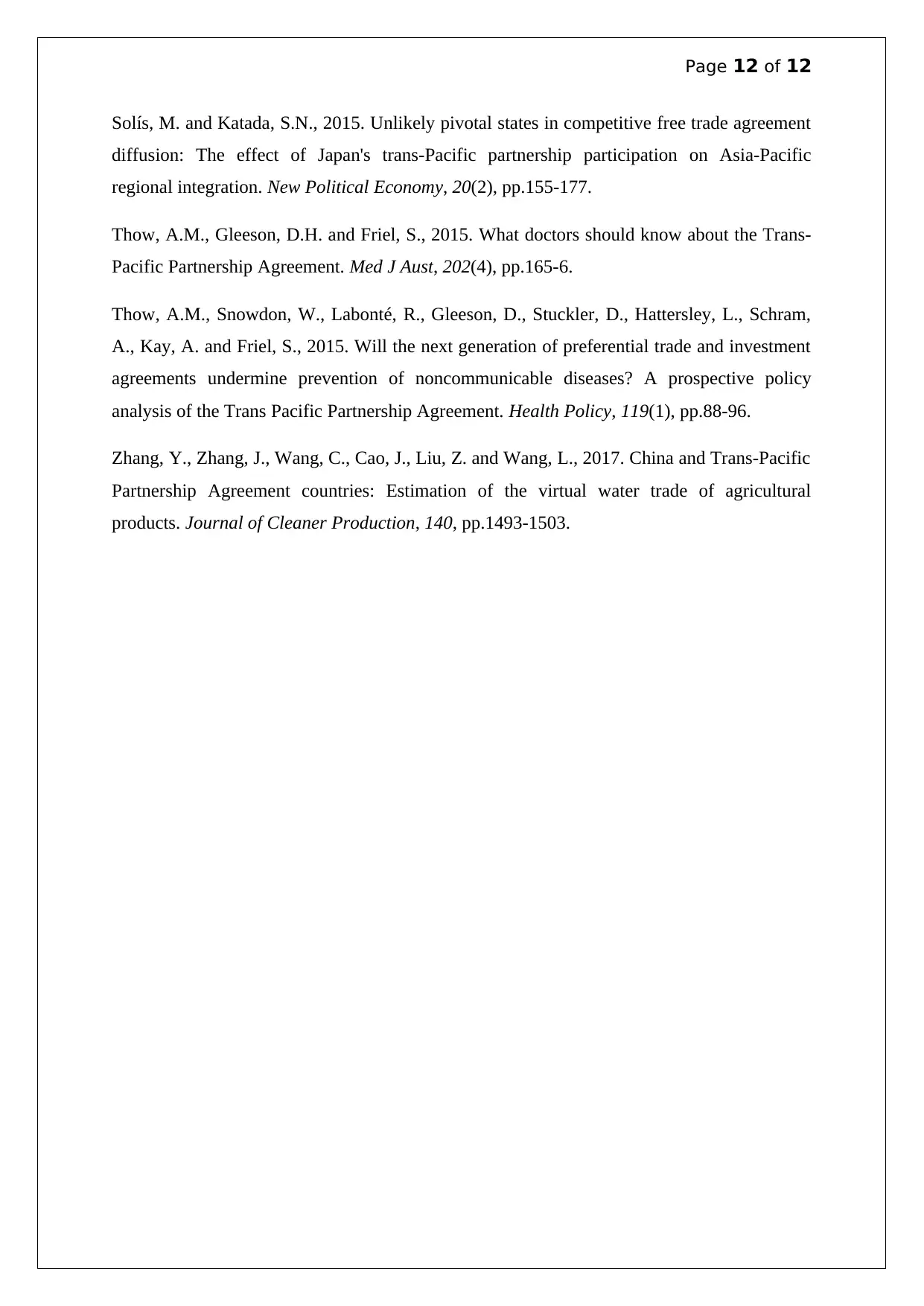
Page 12 of 12
Solís, M. and Katada, S.N., 2015. Unlikely pivotal states in competitive free trade agreement
diffusion: The effect of Japan's trans-Pacific partnership participation on Asia-Pacific
regional integration. New Political Economy, 20(2), pp.155-177.
Thow, A.M., Gleeson, D.H. and Friel, S., 2015. What doctors should know about the Trans-
Pacific Partnership Agreement. Med J Aust, 202(4), pp.165-6.
Thow, A.M., Snowdon, W., Labonté, R., Gleeson, D., Stuckler, D., Hattersley, L., Schram,
A., Kay, A. and Friel, S., 2015. Will the next generation of preferential trade and investment
agreements undermine prevention of noncommunicable diseases? A prospective policy
analysis of the Trans Pacific Partnership Agreement. Health Policy, 119(1), pp.88-96.
Zhang, Y., Zhang, J., Wang, C., Cao, J., Liu, Z. and Wang, L., 2017. China and Trans-Pacific
Partnership Agreement countries: Estimation of the virtual water trade of agricultural
products. Journal of Cleaner Production, 140, pp.1493-1503.
Solís, M. and Katada, S.N., 2015. Unlikely pivotal states in competitive free trade agreement
diffusion: The effect of Japan's trans-Pacific partnership participation on Asia-Pacific
regional integration. New Political Economy, 20(2), pp.155-177.
Thow, A.M., Gleeson, D.H. and Friel, S., 2015. What doctors should know about the Trans-
Pacific Partnership Agreement. Med J Aust, 202(4), pp.165-6.
Thow, A.M., Snowdon, W., Labonté, R., Gleeson, D., Stuckler, D., Hattersley, L., Schram,
A., Kay, A. and Friel, S., 2015. Will the next generation of preferential trade and investment
agreements undermine prevention of noncommunicable diseases? A prospective policy
analysis of the Trans Pacific Partnership Agreement. Health Policy, 119(1), pp.88-96.
Zhang, Y., Zhang, J., Wang, C., Cao, J., Liu, Z. and Wang, L., 2017. China and Trans-Pacific
Partnership Agreement countries: Estimation of the virtual water trade of agricultural
products. Journal of Cleaner Production, 140, pp.1493-1503.
⊘ This is a preview!⊘
Do you want full access?
Subscribe today to unlock all pages.

Trusted by 1+ million students worldwide
1 out of 12
Related Documents
Your All-in-One AI-Powered Toolkit for Academic Success.
+13062052269
info@desklib.com
Available 24*7 on WhatsApp / Email
![[object Object]](/_next/static/media/star-bottom.7253800d.svg)
Unlock your academic potential
Copyright © 2020–2025 A2Z Services. All Rights Reserved. Developed and managed by ZUCOL.




